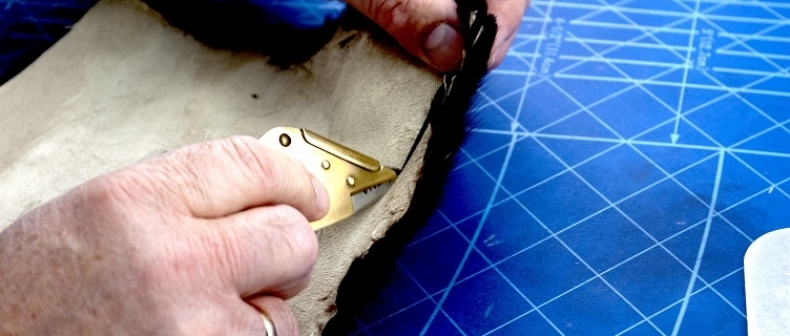
Toronto furrier Chris Anthopoulos, with his fur seamstress. All Images: Lucas Van Meer-Mass
By: Lucas Van Meer-Mass
Arnold Shear was 18 when he first started as a fur salesman for Bender Goodman Furs at Adelaide and Peter Streets in 1948. Lower Spadina was then the centre of a thriving fur trade defined by the craftsmanship, culture, history and politics of its main practitioners: families of Jewish furriers from all parts of the Russian Pale of Settlement. Cutters, shearers, dyers and sewers, they dealt in everything from skunk to Russian sable. Intermarriages, labour disputes and the intense competition provided ample drama.
Mr. Shear and Paul Magder, another furrier in the trade for over 50 years, now sit together in a small fur shop on Dundas West that they share with a third furrier. Gone are the spacious showrooms and bustling workshops of the companies they once owned on Spadina. Changing fashions, rising rents in downtown, offshore manufacturing and, not least of all, the animal rights movement have reduced the trade to a fraction of what it once was in Toronto. They nevertheless remain proud of their work, reminiscing and commiserating about the trade they dedicated their lives to. With the resurgent appeal of hand-made goods with ‘authentic’ traditions, Mr. Magder and Mr. Shear represent the persistence of a trade whose roots in Toronto are deeper than those of any others.
The fur trade used to define a large part of downtown Toronto and, indeed the country at large. Canadian political economist Harold Innis once famously wrote that “It is impossible to understand the characteristic developments of … Canadian history without some knowledge of [the beaver’s] life and habits.” By the 1920’s beaver had largely fallen out of fashion on lower Spadina and immigrants from Eastern Europe were beginning to take over for English and Scottish furriers. Fur nevertheless remained in high demand across the social spectrum. “Rich people wore Alaskan seal, middle class wore Hudson seal and the poor people wore rabbit”, says Mr. Magder, whose father arrived from Romania in 1910. Hudson seal, mind you, was just sheared dyed muskrat.
Jewish entrance into the fur industry played a formative role in Toronto’s Jewish and labour history. Fiery fur trade worker and union organizer Max Federman, still spoken of by furriers today, exemplified this dynamic and radical time. His oral history, recorded for posterity at the Ontario Jewish Archives, describes in detail a childhood of coal mining in Germany, his arrival in Toronto and the ensuing ideological struggles and labour strife, and even a chummy conversation with visiting anarchist activist Emma Goldman outside a Spadina union hall in 1928.
“This was actually the beginning of Jewish life in Toronto.” Federman says over the warped magnetic tape of his 1976 oral history. With the arrival of Jewish immigrants, a Yiddish-speaking local of the furrier union had to be formed. Eventually led by Federman, the furriers union achieved important concessions long before other industries. Before long, an astounding array of political and cultural organizations had sprng up around the Jewish community in the ‘needle trades’. Following the war, The Canadian Overseas Fur Commission scoured European displaced persons camps for Jews to join the trade in Toronto and refugees to Canada soon joined the established Jewish community. Hundreds arrived by boat from Europe and received training and support in Spadina’s synagogues, fraternal organizations and workshops.
Consistent Jewish upward mobility brought demand for a newer skilled immigrant class. Beginning in the 1950s Greeks began to enter the trade they now dominate today. Most came from around town of Kastoria, a name that is a cognate of the Greek word for beaver. These Greek furriers came from families that had been furriers since their town served as a stopping point on the Roman winter road between Rome and Constantinople.
Chris Anthopoulos, owner of Yukon Furs on Spadina, was once such immigrant. Learning the trade from his uncle in Kastoria, Mr. Anthopoulos came to Canada in 1949, in flight from bloody Greek Civil War. By the mid-fifties he had established his own shop. The radical politics of earlier years had largely faded by the time of his arrival. Significant labour gains and the sidelining of communist and anarchist elements had taken the fire out of the movement. Where once Jews out-competed the Scottish and English, Greeks now seized the competitive edge, employing family members in smaller, non-union shops.
An earnest and mirthful character, Mr. Anthopoulos is immensely proud of his trade, its history and its craftsmanship. “Because of this industry this great nation was founded,” he says. He admires those who came before, recently calling the remaining Jewish furriers he knows to wish them a happy Passover.
Mr. Anthopoulos shows off his blackgama mink fursOther furriers in turn, admire Mr. Anthopoulos’ skill and style. As he demonstrates the cutting of a skin in the back room of his shop, his deft hand quickly preparing a Blackglama-mink skin, the skill is evident. Bespoke tailoring comprises most of Mr. Anthopoulos’ business these days. Wholesale manufacturing has almost entirely relocated to China. What remains are more upscale establishments like Yukon Furs, where furriers are involved in every step of the process. Mr. Anthopoulos purchases raw furs from trapper cooperatives in Northern Ontario and is closely involved with the making of every garment up until its final fittings and tailoring. “I only buy the crème” he says, “The best there is.”
Those seeking something expertly made come to Mr. Anthopoulos but the styles, it must be said, are ostentatious. Mr. Anthopoulos shows me billowing fox fur cuffs, Namibian Swakara hats and a full length coat depicting the Chrysler Building. While opinions on style may differ, it is clear that fur in Toronto is now entirely a luxury item. The customers I encounter are mostly ladies of a certain age and of definite means. Mr. Anthopoulos proudly holds up a garment he is working on now. It is an overcoat for a professional football player. He is unwilling to disclose just who the coat is for, but we can reasonably assume that the coat, itself taller than Mr. Anthopoulos and expected to fetch $19,000, is not for a CFLer.
Mr. Anthopoulos’ skill and artistry have made him an exceptional success but the fate of the fur industry at large is in constant peril. The anti-seal hunt campaign against the east coast Harp seal cull has meant that the market for all seal garments, and even those slyly just listed as seal, has disappeared. “They ruined the whole business!” says Mr. Shear back in his Dundas West store. But the business has faced severe criticism for decades over the inhumane treatment of most every animal used for fur.
The old-timers seem more confounded than angry when the topic is broached. They are harangued and harassed on the basis of ethical principles strange and abstract to those that informed their trade and upbringing. But the fur trade is of a different time and exists at the mercy of forces outside itself now. For now Mr. Magder and Mr. Shear will continue to serve the clients they have known for decades and keep the fur trade alive for at least another couple of years.
—-
Lucas Van Meer-Mass is a freelance writer and regular contributor to the Toronto Review of Books. This is his first piece for Toronto Standard. Follow him on Twitter at @lvmmass
For more, follow us on Twitter at @TorontoStandard and subscribe to our newsletter.














